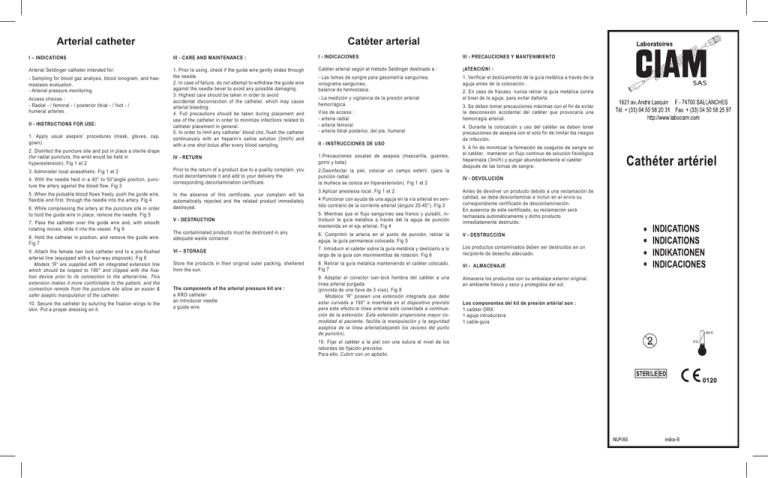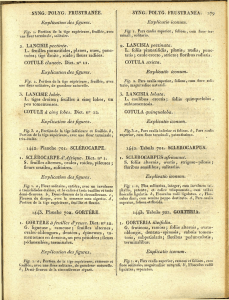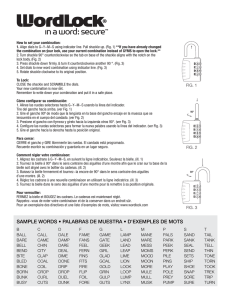Arterial catheter Catéter arterial
Anuncio

Arterial catheter Catéter arterial I – INDICATIONS III - CARE AND MAINTENANCE : I - INDICACIONES III - PRECAUCIONES Y MANTENIMIENTO Arterial Seldinger catheter intended for: 1. Prior to using, check if the guide wire gently slides through the needle. 2. In case of failure, do not attempt to withdraw the guide wire against the needle bevel to avoid any possible damaging. 3. Highest care should be taken in order to avoid accidental disconnection of the catheter, which may cause arterial bleeding. 4. Full precautions should be taken during placement and use of the catheter in order to minimize infections related to catheter placement in general. 5. In order to limit any catheter’ blood clot, flush the catheter continuously with an heparin’s saline solution (3ml/h) and with a one shot bolus after every blood sampling. IV - RETURN Catéter arterial según el método Seldinger destinado a : ¡ATENCION! : - Las tomas de sangre para gasometría sanguínea, ionograma sanguíneo, balance de hemostasia. 1. Verificar el deslizamiento de la guía metálica a través de la aguja antes de la colocación . Prior to the return of a product due to a quality complain, you must decontaminate it and add to your delivery the corresponding decontamination certificate. 2.Desinfectar la piel, colocar un campo estéril, (para la punción radial, la muñeca se coloca en hiperextensión). Fig 1 et 2 - Sampling for blood gaz analysis, blood ionogram, and haemostasis evaluation. - Arterial pressure monitoring. Access choices : - Radial - / femoral - / posterior tibial - / foot - / humeral arteries . II - INSTRUCTIONS FOR USE: 1. Apply usual asepsis’ procedures (mask, gloves, cap, gown). 2. Disinfect the puncture site and put in place a sterile drape (for radial puncture, the wrist would be held in hyperextension). Fig 1 et 2 3. Administer local anaesthetic. Fig 1 et 2 4. With the needle held in a 40° to 50°angle position, puncture the artery against the blood flow. Fig 3 5. When the pulsatile blood flows freely, push the guide wire, flexible end first, through the needle into the artery. Fig 4 6. While compressing the artery at the puncture site in order to hold the guide wire in place, remove the needle. Fig 5 7. Pass the catheter over the guide wire and, with smooth rotating moves, slide it into the vessel. Fig 6 8. Hold the catheter in position, and remove the guide wire. Fig 7 9. Attach the female luer lock catheter end to a pre-flushed arterial line (equipped with a four-way stopcock). Fig 8 Models “R” are supplied with an integrated extension line which should be looped to 180° and clipped with the fixation device prior to its connection to the arterial-line. This extension makes it more comfortable to the patient, and the connection remote from the puncture site allow an easier & safer aseptic manipulation of the catheter. 10. Secure the catheter by suturing the fixation wings to the skin. Put a proper dressing on it. In the absence of this certificate, your complain will be automatically rejected and the related product immediately destroyed. V - DESTRUCTION The contaminated products must be destroyed in any adequate waste container. - La medición y vigilancia de la presión arterial hemorrágica. Vías de acceso : - arteria radial - arteria femoral - arteria tibial posterior, del pie, humeral II - INSTRUCCIONES DE USO 1.Precauciones usuales de asepsia (mascarilla, guantes, gorro y bata). 3.Aplicar anestesia local. Fig 1 et 2 4.Puncionar con ayuda de una aguja en la vía arterial en sentido contrario de la corriente arterial (ángulo 35-45°). Fig 3 5. Mientras que el flujo sanguíneo sea franco y pulsátil, introducir la guía metálica a través del la aguja de punción mantenida en el eje arterial. Fig 4 6. Comprimir la arteria en el punto de punción, retirar la aguja, la guía permanece colocada. Fig 5 2. En caso de fracaso. nunca retirar la guía metálica contra el bisel de la aguja, para evitar dañarla. 3. Se deben tomar precauciones máximas con el fin de evitar la desconexión accidental del catéter que provocaría una hemorragia arterial. 4. Durante la colocación y uso del catéter se deben tonar precauciones de asepsia con el solo fin de limitar los riesgos de infección. 5. A fin de minimizar la formación de coagulos de sangre en el catéter, mantener un flujo continuo de solución fisiológica heparinaza (3ml/h) y purgar abundantemente el catéter después de las tornas de sangre. IV - DEVOLUCIÓN Antes de devolver un producto debido a una reclamación de calidad, se debe descontaminar e incluir en el envío su correspondiente certificado de descontaminación. En ausencia de este certificado, su reclamación será rechazada automáticamente y dicho producto inmediatamente destruido. V - DESTRUCCIÓN VI – STORAGE 7. Introducir el catéter sobre la guía metálica y deslizarlo a lo largo de la guía con movimientitos de rotación. Fig 6 Los productos contaminados deben ser destruidos en un recipiente de desecho adecuado. Store the products in their original outer packing, sheltered from the sun. 8. Retirar la guía metálica manteniendo el catéter colocado. Fig 7 VI - ALMACENAJE The components of the arterial pressure kit are : a XRO catheter an introducer needle a guide wire 9. Adaptar el conector luer-lock hembra del catéter a una linea arterial purgada (provista de una llave de 3 vías). Fig 8 Modelos “R” poseen una extensión integrada que debe estar curvada a 180° e insertada en el dispositivo previsto para este efecto,la línea arterial esta conectada a continuación de la extensión. Esta extensión proporciona mayor comodidad al paciente, facilita la manipulación y la seguridad aséptica de la línea arterial(alejando los racores del punto de punción). 10. Fijar el catéter a la piel con una sutura el nivel de los rebordes de fijación previstos Para ello. Cubrir con un apósito. Almacene los productos con su embalaje exterior original, en ambiente fresco y seco y protegidos del sol. Los componentes del kit de presión artérial son : 1 catéter ORX 1 aguja introductora 1 cable-guía Cathéter artériel Fig.1 Fig.2 I - INDICATIONS III – ENTRETIEN & PRECAUTIONS I – INDIKATIONEN III - VORSCHRIFTEN UND PFLEGE : Cathéter artériel selon la méthode de Seldinger destiné à : 1. Vérifier le glissement du guide spiralé dans l’aiguille avant la ponction. Arterienkatheter nach der Seldinger Methode zur : BESONDERS ZU BEACHTEN : - Blutentnahme für Blutgasanalysis, Blutionogramm, Hämostasisbilanz - Messung und Überwachung des arteriellen Blutdrucks 1. Vor dem Einführen freies Gleiten des Führungsdrahtes durch die Nadel prüfen. - des prélèvements pour gaz du sang, ionogramme sanguin, bilan d’hémostase - la mesure et la surveillance de la pression artérielle sanglante Voies d’abord : - artère radiale - artère fémorale - artères tibiale postérieure, pédieuse, humérale II - NOTICE D’UTILISATION Fig.3 1. Précautions usuelles d’asepsie (masque, gants, calot, casaque). 2. Désinfecter la peau, placer un champ stérile, (pour la ponction radiale, la main en décubitus vers le haut, poignet en hyper extension). Fig 1 et 2 3. Pratiquer une anesthésie locale. Fig 1 et 2 Fig.4 4. Ponctionner l’artère à l’aide de l’aiguille, à contresens du flux artériel. (angle de ponction optimal de 40 à 50°) Fig 3 5. Lorsque le flux sanguin est franc et pulsatif, introduire le guide spiralé métallique à travers l’aiguille de ponction maintenue dans l’axe artériel. Fig 4 6. Comprimer l’artère au point de ponction, retirer l’aiguille, le guide étant maintenu en place. Fig 5 Fig.5 7. Introduire le cathéter sur le guide spiralé et le glisser le long du guide en effectuant de légères rotations au passage de la peau. Fig 6 8. Retirer le guide spiralé. Fig 7 9. Connecter l’embase femelle luer-lock du cathéter à une ligne artérielle purgée (munie d’un robinet 3 voies). Fig 8 Fig.6 les modèles «R» incluent une extension intégrée qui doit être courbée à 180° et encliquetée dans le clip prévu à cet effet, la ligne artérielle étant ensuite connectée à l’extension. Celle-ci offre un confort accru au patient, facilite la manipulation et la sécurisation aseptique de la ligne artérielle (éloignement des diverses connexions du point de ponction). 10. Fixer le cathéter à la peau avec une suture au niveau des ailettes d’embase appropriées. Faire un pansement. Fig.7 Fig.8 Arterienkatheter 2. En cas d’échec, ne jamais retirer le guide spiralé contre le biseau de l’aiguille afin d’éviter de l’endommager. 3. Des précautions maximales doivent être prises pour prévenir la déconnexion accidentelle du cathéter pouvant entraîner une hémorragie artérielle. 4. Des mesures d’asepsie doivent être prises lors de la pose et de la manipulation du cathéter afin de limiter les risques d’infection liés à l’utilisation de cathéter. 5. Pour minimiser la formation de thrombus dans le cathéter, entretenir celui-ci en continu en le flushant avec une solution physiologique héparinée (3ml/h), et, le purger abondamment après un prélèvement sanguin. IV – RETOUR Tout produit retourné aux Laboratoires CIAM doit être préalablement décontaminé et accompagné de son certificat de décontamination. Le défaut de ce certificat entraînera le rejet de la réclamation et la destruction immédiate du produit concerné. V – DESTRUCTION Eliminer les produits dans un récipient prévu pour les dispositifs souillés. VI – STOCKAGE Stocker les produits dans leur emballage d’origine, dans un endroit sec et tempéré, à l’abri des rayons du soleil. Zugangswege : - Arteria Radialis - Arteria Femoralis - Arteriae Tibialis, bzw. Dorsalis Pedis oder Humeralis II – GEBRAUCHSANWEISUNG 1. Übliche aseptische Vorschriften (Maske, Handschuhe, Haube, Kittel) 2. Haut desinfizieren, steriles Feld positionieren (für die radiale Punktion wird die Hand nach oben gelegt, Handgelenk in Hyperextension). Fig 1 et 2 3. Lokalanästhesie durchführen. Fig 1 et 2 3. Es müssen maximale Vorschriften getroffen werden, um jede unbeabsichtigte Loslösung des Katheters zu vermeiden, welche zu einer arteriellen Blutung führen könnte. 4. Übliche aseptische Vorschriften beim Einführen und auch bei der Handhabung des Katheters sind erforderlich, um die mit der Anwendung des Katheters gebundenen Infektionsrisiken zu vermeiden. 5. Um jeden Katheter-Thrombus zu vermeiden, empfiehlt es sich den Katheter kontinuierlich mit einer Heparin-Infusionslösung (3ml/St.) und besonders nach Blutentnahmen zu spülen. 4. Mit der Nadel stromaufwärts die Arterie punktieren (Winkel 40 bis 50°). Fig 3 IV – RÜCKSENDUNGSREGELN 5. Nach freiem und pulsartigem erhaltenem Blutstrom wird der Führungsdraht durch die in der Langsachse der Arterie gehaltene Punktionsnadel vorgeschoben. Fig 4 Bei jeder Rücksendung eines benutzten, bzw. fehlerhaften Produkts muß unbedingt das betreffende Dekontaminationszeugnis dem Produkt beigelegt werden. 6. Arterie an Punktionsstelle komprimieren, Führungsdraht an der Stelle Halten, Nadel zurückziehen. Fig 5 7. Katheter auf dem Führungsdraht hineingleiten lassen und mit leichten Drehbewegungen in die Arterie hineinschieben. Fig 6 8. Führungsdraht zurückziehen und entfernen. Fig 7 Le set de pression artérielle est composé de : un cathéter radio-opaque une aiguille introductrice un guide spiralé droit 2. Im Falle des Miβlingens den Führungsdraht gegen die abgeschrägte Nadelkante nie zurückziehen, um die Gefahr seiner Beschädigung zu vermeiden. 9.Weiblicher Luer-Lock-Ansatz an eine gespülte Arterienlinie (mit 4- Wege-Hahn) anschlieβen. Fig 8 Modelle“R” verfügen über eine integrierte Zuleitung, die in die hierzu vorgesehene Klipp-Halterung zum 180°gebogen und dann eingeklickt wird. Die Arterienlinie ist dann an die Zuleitung angeschloβen. Diese Zuleitung bietet dem Patienten Komfort, erleichtert und sichert die aseptische Manipulation der Arterienlinie (durch Entfernung der Verbindungen von der Punktionsstelle). 10. Katheteransatz dank der Befestigungsflügel an Haut nähen. Verband anlegen. Das Mangel an diesem Zeugnis wird zur unmittelbaren Zurückweisung der Reklamation und sofortigen Zerstörung des betroffenen Produkts führen. V - ENTSORGUNG / ZERSTÖRUNG Die beschmutzen Produkte in den dazu vorgesehenen Abfallsbehälter entsorgen. VI – LAGERUNG Die Produkte in der Originalaußenpackung, vom Sonnenlicht geschützt, lagern. Das Set für arterielle Druckmessung besteht aus : einem röntgendichten Katheter einer Einführungskanüle einem Spiralmandrin

